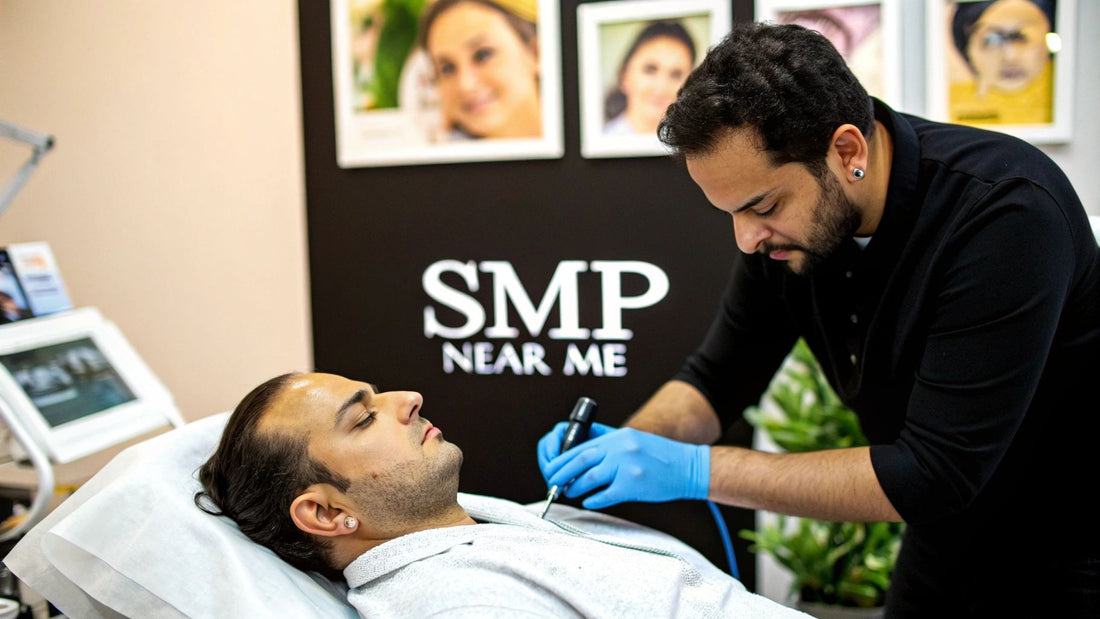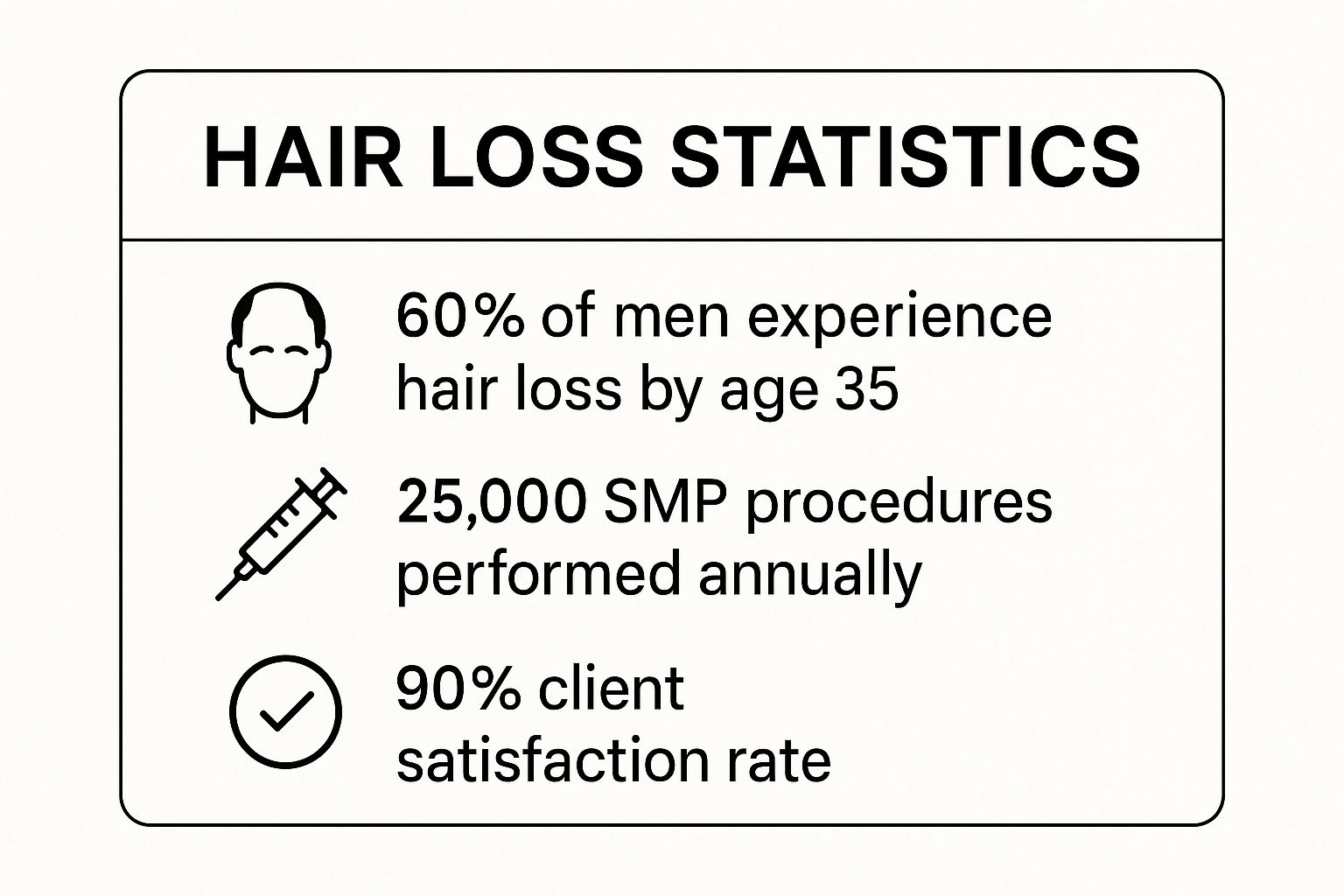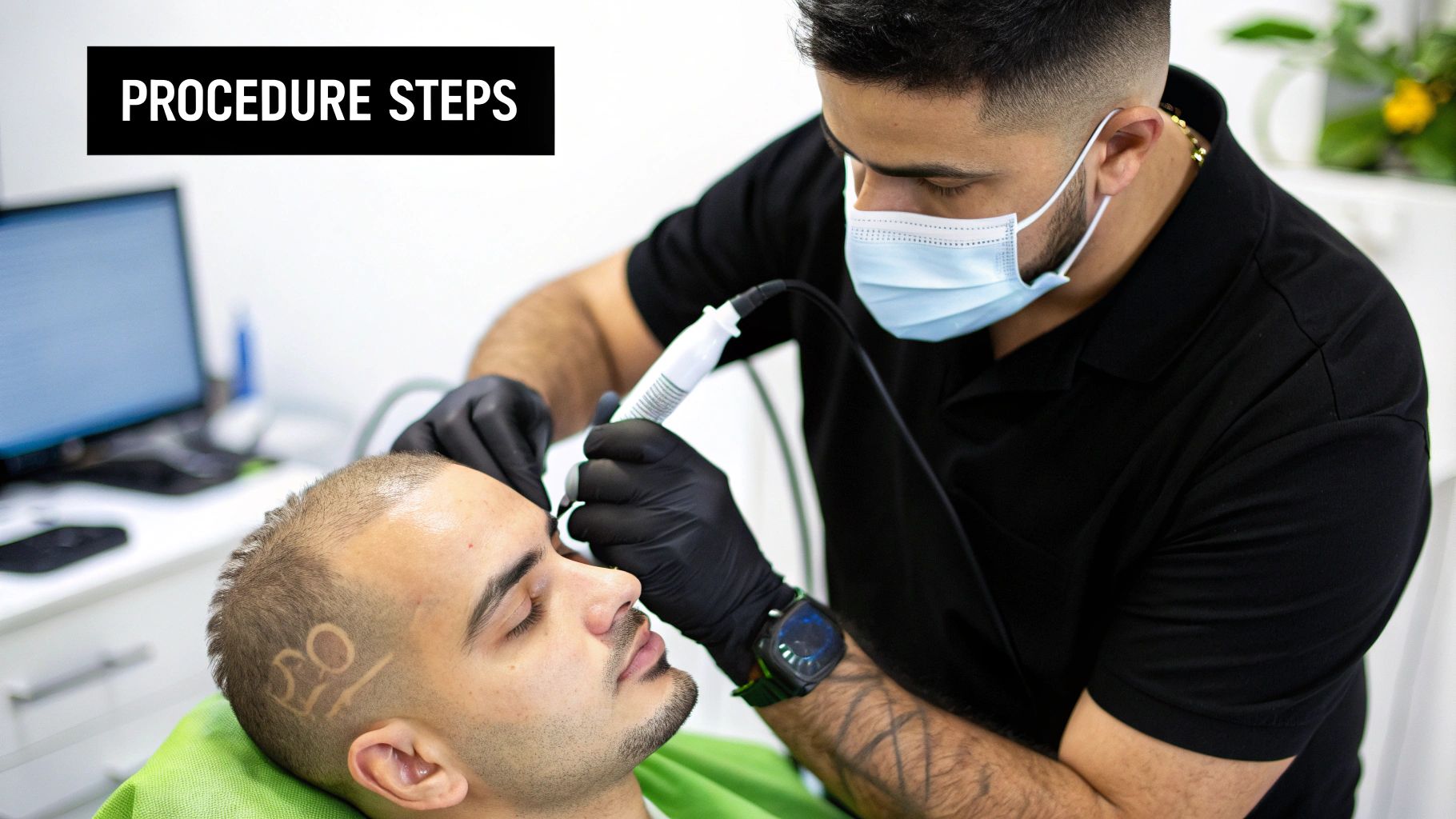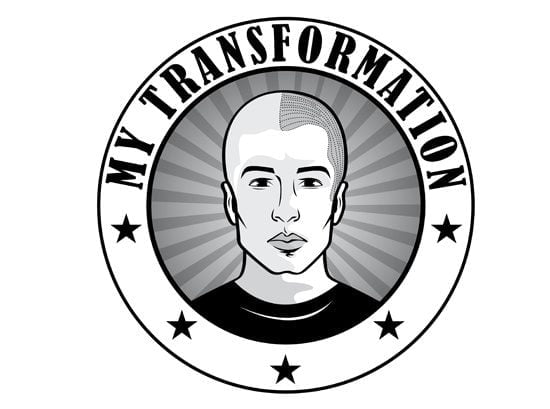
Scalp Micropigmentation Near Me A Guide to Top Clinics
Share
When you type "scalp micropigmentation near me" into a search bar, you’re not just looking for a map with pins. You’re on the hunt for a solution—a local professional you can genuinely trust with something as personal as your appearance and confidence. So, the first step isn't just about finding who's closest. It’s about creating a smart plan to find the right one for you.
How to Actually Find a Great SMP Clinic Nearby
That initial search can throw a lot at you, with countless clinics all trying to get your attention. Let's move beyond a basic Google query and start thinking like an investigator.
Instead of just typing in the service name, get more specific. Try searching for things like:
- "best scalp micropigmentation Melbourne"
- "natural SMP hairlines Sydney"
- "SMP artist for thinning hair Perth"
These targeted searches help cut through the noise and surface the specialists who are known for their quality work, not just their marketing budget.
Social media, especially Instagram, is your best friend here. But don't just scroll through a clinic's perfectly polished feed. The real gold is in their tagged photos. Clicking on these shows you results on actual clients, often posted by the clients themselves. It’s an unfiltered, honest look at what their work looks like in the real world.
This infographic paints a clear picture of why finding a great artist is so crucial.

The numbers show that while hair loss is incredibly common, SMP stands out as a highly effective solution with a fantastic satisfaction rate. This makes your search for a skilled local artist not just important, but essential for getting the result you want.
Refining Your Search Strategy
Here in Australia, scalp micropigmentation has absolutely exploded in popularity. It's no wonder, given that around 85% of men and 33% of women will face significant hair thinning at some point. For many, SMP offers a practical, confidence-boosting answer to a very common problem.
To help you narrow down your options effectively, I've put together a quick checklist. These are the non-negotiables I tell anyone to look for when vetting a potential clinic.
Quick Checklist for Vetting a Local SMP Clinic
| Quality Factor | What to Look For | Why It Matters |
|---|---|---|
| Healed Results | A portfolio with plenty of photos of healed work (at least a few weeks post-treatment), not just fresh sessions. | Fresh SMP always looks sharp. Healed results show the artist's true skill in pigment selection and depth control, ensuring it stays natural-looking long-term. |
| Specialisation | The clinic focuses primarily or exclusively on scalp micropigmentation. | SMP is a highly specialised skill. A dedicated SMP artist will have far more experience than a generalist who offers it as one of many services. |
| Artist Experience | A clear track record with years of experience and a high volume of clients. | An experienced artist has dealt with countless scalp types, skin tones, and hair loss patterns. This experience is priceless. |
| In-Person Consultation | They offer a free, no-obligation consultation to meet the artist and discuss your goals. | This is your chance to gauge their professionalism, see the clinic, and ensure you feel comfortable and understood. A good artist will never pressure you. |
| Honest Communication | The artist is transparent about what SMP can and cannot do. They manage your expectations realistically. | Honesty is key. If an artist promises a result that sounds too good to be true, it probably is. You want a partner, not a salesperson. |
Using this framework helps you move from a long list of possibilities to a short list of high-quality contenders.
A great search strategy isn’t about finding every single option out there. It’s about quickly and efficiently weeding out the wrong ones. Keep your focus on clinics that proudly showcase their healed results—that’s the real proof of lasting quality.
As you build that shortlist, remember that for many people, https://www.mytransformation.com.au/blogs/news/scalp-micropigmentation-is-the-answer-to-hair-loss, but the final outcome rests entirely on the skill of the artist. While this guide is tailored for SMP, these core principles hold true for any cosmetic procedure. If you’re interested in a broader view, there are some great resources on finding your ideal aesthetic clinic nearby.
How to Read an SMP Portfolio Like a Pro

So you've Googled "scalp micropigmentation near me" and have a shortlist of clinics. Now for the most crucial part: digging into their portfolios. This is where you separate the true artists from the rest. You need to look past the slick marketing shots and learn to spot the subtle signs of genuinely high-quality work.
It all starts with the hairline design. This is the first thing you'll notice, and it's a dead giveaway of an artist's skill. A masterful hairline is never a harsh, ruler-straight line. It should look natural—soft, slightly irregular, and custom-designed to fit the client’s head shape, age, and facial structure. If every client has the same sharp hairline, that's a massive red flag.
Look for Healed Work, Not Just Fresh Ink
This is a big one. Always hunt for photos of healed results. Freshly completed SMP always looks darker and more defined than it will after it settles. The real test of an artist's ability is what their work looks like weeks or months later.
Here's what to zero in on when looking at healed photos:
- Flawless Blending: The pigment should blend so seamlessly with any real hair that you can't tell where one ends and the other begins. It should just look like a full, dense head of hair.
- Realistic Follicle Replication: Look closely at the individual dots. They should be incredibly small and consistently sized, perfectly mimicking natural hair follicles. If you see large, smudged, or "blown-out" dots, it’s a clear sign of poor technique.
- Perfect Colour Matching: The pigment’s tone must be a spot-on match for the client’s remaining hair and skin undertones. Any hint of a blueish or overly ashy tone means the artist either used the wrong pigment or didn't have the experience to get it right.
Think of an artist's portfolio as their CV. If it's filled with blurry photos, only shows fresh work, or features the same two clients over and over, that's an incomplete application. True mastery is shown in crystal-clear photos of varied, beautifully healed results.
The demand for non-surgical hair loss treatments is booming, and Australian SMP clinics are performing thousands of procedures every year. A key reason is its effectiveness for androgenetic alopecia, which is behind 95% of hair loss cases. You can get a better sense of hair loss prevalence from these comprehensive hair loss statistics.
This popularity means there are more artists than ever, making your ability to properly critique a portfolio absolutely vital. By focusing on the finer points—hairline softness, seamless blending, and healed outcomes—you can choose a practitioner whose work truly speaks for itself.
What a Great SMP Consultation Feels Like

So, you've done your homework and found a few promising "scalp micropigmentation near me" options. The next step—the consultation—is where you really separate the true artists from the rest. This isn’t a sales pitch. It should feel like a genuine, in-depth conversation where you’re both figuring out if you're a good fit for each other.
A real professional is vetting you just as much as you're vetting them. They need to understand your hair loss journey, your lifestyle, and what you’re genuinely hoping to achieve with SMP. If it feels rushed or you’re getting hit with high-pressure sales tactics, that’s a massive red flag. Trust your gut and walk away.
Key Questions You Must Ask
This is your moment to dig deep and get a feel for their expertise and honesty. Don't hold back; a confident, experienced artist will be happy to answer everything you throw at them.
Here’s what you should be asking:
- Training and Experience: Where did you get your training? Critically, how long have you been practising scalp micropigmentation exclusively? You want someone who lives and breathes SMP, not a generalist.
- Pigment Knowledge: What brand of pigment do you use, and why did you choose it? They should be able to clearly explain how their chosen pigments resist changing colour over time—the dreaded blue or green tinge is a real risk with low-quality ink.
- Hygiene and Safety: Talk to me about your sterilisation process. You’re looking for specifics: single-use needles, disposable grips, and a clinical-level clean environment.
A great consultation is a two-way street. The artist should be carefully examining your scalp and setting realistic expectations. At the same time, you need to be assessing their skill, transparency, and whether you feel a real sense of trust with them.
Given that androgenetic alopecia (genetic hair loss) affects so many people, getting expert, personalised advice is the only way to ensure your result looks completely natural. This isn't a one-size-fits-all procedure.
The discussion should also cover the practicalities. Ask about pain management options, what the healing process really looks like day-to-day, and the long-term plan for touch-ups down the track.
Getting everything clear from the beginning is vital. We’ve put together a full guide on how to prepare for scalp micropigmentation treatment that walks you through everything you need to know before your first session. This is your chance to get all the answers you need before you commit.
Decoding SMP Pricing and What You're Really Paying For

When you start searching for "scalp micropigmentation near me," it's completely normal for your eyes to drift towards the prices first. But let me give you some hard-won advice from years in this field: with SMP, the cheapest quote is almost always the most expensive one in the long run.
A price that seems too good to be true usually is. It can signal an inexperienced practitioner, cheap pigments that will discolour, or a rushed job. Any of those things can lead you straight down the path of stressful and costly correction work.
Instead of hunting for the lowest number, it's far better to understand what goes into a high-quality treatment. The real value isn't just in the final look, but in the skill, safety, and materials that create a natural result that lasts for years.
What Goes into the Cost?
Think of quality SMP as an investment in artistry and medical-grade safety. The price tag reflects a few non-negotiable elements that any reputable clinic will build into their costs.
Here’s what you’re actually paying for:
- Artist Skill and Reputation: You're investing in an expert's trained hand and artistic eye. A seasoned professional knows how to create those subtle, soft hairlines and blend the treatment seamlessly with your existing hair. That's a skill that takes years to master.
- Premium Pigments: Top-tier, stable pigments are a must. They cost more, but they’re designed to hold their colour and fade naturally over a very long time, not turn into an obvious blue or green smudge.
- Sterile, Professional-Grade Equipment: Your health and safety are paramount. Every single treatment must use new, sterile, single-use needles and sanitised equipment. There is absolutely no room for compromise here.
The biggest factor influencing the total cost is nearly always the extent of your hair loss, which we measure on the Norwood scale. Treating minor recession (Class 2) is a much smaller job and will cost significantly less than a full treatment for someone with advanced hair loss (Class 7).
Ultimately, you’re not just buying ink dots on your head; you're investing in the confidence and peace of mind that comes with a great result.
Taking the time to learn what drives the price will help you assess quotes properly. To get a complete picture, I highly recommend reading our detailed guide on how much scalp micropigmentation costs. It will give you the knowledge to evaluate clinics based on long-term value, not just the initial price.
Getting Ready for Your SMP Sessions and Nailing the Aftercare
You've put in the hard yards to find a top-notch artist, but a truly great scalp micropigmentation result is a team effort. Your role in preparing for your sessions and looking after the work afterwards is just as important as the artist's skill. Think of it as protecting your investment.
Proper preparation is key for any cosmetic treatment. In the same way you’d get ready when preparing for cosmetic procedures like Botox, there are a few simple things you need to do before your SMP appointment to set yourself up for success.
In the 24-48 hours beforehand, steer clear of things that can thin your blood, like fish oil supplements, excessive caffeine, or alcohol. Also, make sure your scalp isn't sunburnt. A red, irritated scalp is the last thing you want, so keep it out of the sun for at least a week prior. A well-hydrated, moisturised scalp takes the pigment much more evenly, so drink plenty of water and use a light moisturiser on the area in the days leading up. It makes a bigger difference than you might think.
Protecting Your Investment: The Aftercare Routine
Once the artist puts down their tools, the baton is passed to you. This is the crucial healing phase where those tiny pigment dots settle in and become the sharp, natural-looking follicles you’re after.
The first few days are absolutely critical. Your scalp is healing, and how you treat it now directly affects how clear and long-lasting your SMP will be. Following the aftercare rules isn't just a suggestion—it's essential.
Here’s a simple timeline to guide you:
- Days 1-4: The golden rule? Do nothing. Seriously. Don't wash it, don't touch it, and definitely no sweating. That means no gym, no saunas, and try to avoid wearing a hat that will rub against the area. Let it heal in peace.
- Days 5-7: You can now give your scalp a very gentle rinse with just water. Pat it dry with a clean towel – don't rub it! Continue to avoid any heavy exercise or activities that cause a lot of sweating.
- Day 7 Onwards: It's now safe to start using a light, fragrance-free moisturiser again. You can also wash your hair with a gentle shampoo. The number one enemy of SMP long-term is the sun, so always protect your scalp with a high-SPF sunscreen or a hat to prevent fading.
For a complete day-by-day plan, our detailed scalp micropigmentation aftercare guide has all the information you need to keep your new look sharp for years to come.
Answering Your Final Questions About Local SMP
Even after doing your homework, it’s completely normal to have a few lingering questions as you search for "scalp micropigmentation near me." Let’s tackle some of the most common ones I hear from clients, so you can move forward feeling sure of your decision.
One of the first things everyone asks is, "Does it hurt?" Honestly, most people find it more annoying than painful. On a scale of one to ten, clients usually put the discomfort at a 2-4 out of 10. It’s less of a sharp pain and more of a persistent, light tapping sensation. Any good practitioner will constantly check in with you, though be prepared for areas with thinner skin, like around the temples, to be a bit more sensitive.
Another big hurdle is trusting online reviews. How do you know what’s real? The trick is to look for detailed stories, not just generic praise.
A vague comment like "great service" doesn't tell you much. A genuine review will often mention the artist by name, describe the vibe of the clinic, what the procedure actually felt like, and—most importantly—how the pigment settled and healed. Those detailed accounts are gold because they almost always come from real people.
Will I Have to Shave My Head?
This is a huge, and very valid, concern for many guys. The answer really comes down to your specific pattern of hair loss and what you're trying to achieve.
- For Significant Balding: If you're dealing with advanced hair loss, particularly on the crown (think a Norwood Scale 4 or higher), then yes, a full head shave is the way to go. It’s the only way to create that seamless, natural-looking buzz cut effect.
- For Adding Density: If you still have a good amount of hair but it's thinning out, you absolutely do not need to shave it all off. In this case, the treatment is done between your existing hair follicles to reduce the contrast with your scalp and create the illusion of thickness.
A proper consultation is where you'll get the final word. Your artist will assess your hair and tell you exactly what’s needed to get the result you want.
At the end of the day, SMP is all about getting your confidence back. While you’re focused on your hair, you might also find it useful to explore broader strategies for enhancing overall male attractiveness that work hand-in-hand with your new look. And if you're still in the early stages of research, our guide explaining what is scalp micropigmentation is a great place to start.
Ready to take the next step and transform your look? My Transformation is dedicated to providing world-class scalp micropigmentation services. Book your free consultation today at https://www.mytransformation.com.au and discover the best hair loss solution for you.
